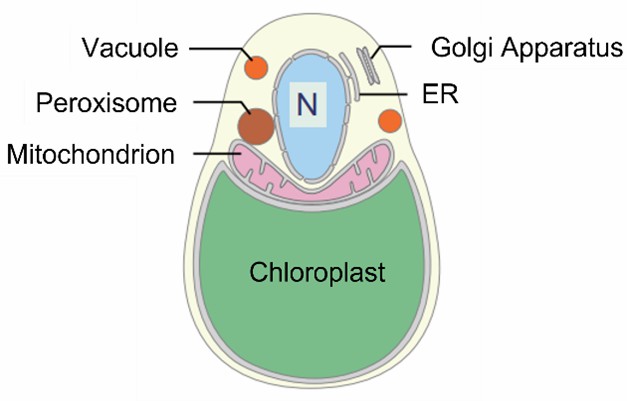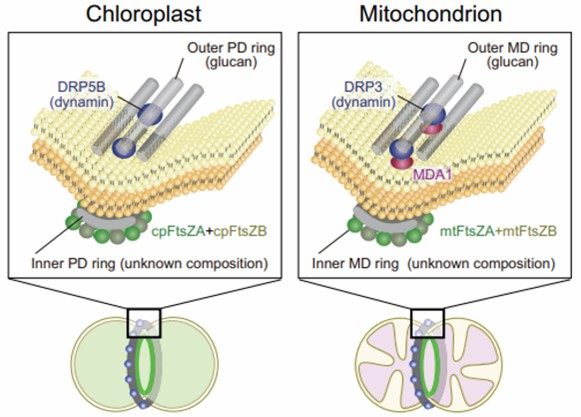Red Algae as a Model Organism
Red algae, also known as Rhodophyta, are one of the oldest eukaryotic algae, containing over 7,000 currently recognized species. Red algae are abundant in marine habitats, but relatively rare in freshwater. About 5% of red algal species occur in freshwater environments, with greater concentrations found in warmer areas.
 Fig.1 Position of red algae in the eukaryotic tree. (Miyagishima, S. Y., & Tanaka, K., 2021, Plant and Cell Physiology)
Fig.1 Position of red algae in the eukaryotic tree. (Miyagishima, S. Y., & Tanaka, K., 2021, Plant and Cell Physiology)
The Unique Structure of Red Algae
As members of the Archaeplastida supergroup, red algae are related to green plants, while they differ from green plants by a series of unusual biochemical and ultrastructural features. The first is that red algae contain stalked phycobilisomes with the purple and red accessory pigments phycocyanin and phycoerythrin produced by unstacked thylakoid membranes. The second is that the carbohydrates of red algae are stored in floridean starch grains in the cytoplasm. As well as from an evolutionary point of view, the most striking feature of red algae is the complete absence of flagella, centrioles, or any other 9+2 structures.
 Fig.2 Pattern diagram of unicellular red algae. (Miyagishima, S. Y., & Tanaka, K., 2021, Plant and Cell Physiology)
Fig.2 Pattern diagram of unicellular red algae. (Miyagishima, S. Y., & Tanaka, K., 2021, Plant and Cell Physiology)
Cyanidioschyzon merolae, a Classic Model Organism
Some species of unicellular eukaryotic algae exhibit relatively simple genomes and cellular structures. In particular, the unicellular red alga Cyanidioschyzon merolae is one of the simplest organisms.
Advantages of Cyanidioschyzon merolae as a Model Organism
It has the fewest membranous organelles, only 4,775 protein-coding genes in its nucleus, and its cell cycle progression can be highly synchronized with the circadian cycle. These properties facilitate diverse allosteric analysis of cell proliferation and structural analysis between organelles. Cyanidioschyzon merolae cells lack a rigid cell wall and are therefore relatively easy to disrupt for biochemical analysis.
In addition, a large number of molecular tools have now been developed to facilitate the study of the mechanisms of physiological activity of red algae.
Therefore, Cyanidioschyzon merolae can provide important insights into the biology of photosynthetic eukaryotes, both individually and in comparative and combinatorial studies with other photosynthetic organisms.
Diverse Research Areas
As a kind of typical, simple, and easy-to-manipulate model organism, red algae are used in many fields of research.
- Cytoskeletal Processes
Mechanisms of cytoskeletal processes, such as cell motility, cell division, intracellular transport, and secretion. - Mechanisms of the Cell Cycle
Molecular mechanisms of mitochondrial and chloroplast division and their coordination with the host cell cycle, as well as the coordination of chloroplast and mitochondrial DNA replication with the host cell cycle. - Responses to Environmental Changes
Response and mechanism to nutrient starvation, to different CO2 concentrations, and to different intensities and types of light signals. - Study of Metabolic Pathways
Whether transcriptome changes in metabolic pathways are regulated by the cell cycle, the molecular basis of nocturnal restriction of cell division, and the study and engineering of metabolic pathways for commercially valuable substances.
 Fig.3 A diagram showing the structure of chloroplast division machinery in Cyanidioschyzon merolae. (Miyagishima, S. Y., & Tanaka, K., 2021, Plant and Cell Physiology)
Fig.3 A diagram showing the structure of chloroplast division machinery in Cyanidioschyzon merolae. (Miyagishima, S. Y., & Tanaka, K., 2021, Plant and Cell Physiology)
Our Services
Lifeasible has been working on algae for many years and is capable to offer reliable and high-quality algae isolation and culture services, algae engineering services, algae analysis services, algae genetic screening services, algae-based production services, algae monitoring services, algae treatment services, and algae-based biosensor services for environmental monitoring. It is our glad to share our technology and experiences with you. Please contact us for more information.
Reference
- Miyagishima, S. Y., & Tanaka, K. (2021). The unicellular red alga Cyanidioschyzon merolae—the simplest model of a photosynthetic eukaryote. Plant and Cell Physiology, 62(6), 926-941.
Our services are for research use only and not for any clinical use.